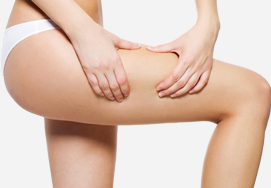Thigh Lift
Suitable for a non-smoker or non-drinker, and psychologically healthy individuals with realistic expectations for the procedure

- What is thigh lift surgery?
- What the thigh lift won’t do?
- What are the types of the surgeries?
- Which individuals are eligible for the surgery?
- How should I prepare for the surgery?
- What will happen during the surgery?
- What is the aftercare of the surgery?
- What are the postsurgical considerations?
What is thigh lift surgery?
A thigh lift surgery or thighplasty helps to reform the outline of your thighs by removing the excess skin, fat and tissue thereby toning them. This surgery thereby results in better-proportioned contours of the upper legs and lower body.
What the thigh lift won’t do?
Thigh lifts are not intended strictly for the removal of excess fat. Liposuction alone can remove excess fat deposits where skin has good elasticity and is able to naturally conform to new body contours.
In cases where skin elasticity is poor, a combination of liposuction and thigh lift techniques may be recommended.
What are the types of the surgeries?
Your surgeon may explain the different types and techniques of thigh lift surgeries and you both may discuss and choose an ideal technique which best suits you depending on particular medical needs, physical appearance, and desired results. The thigh lift surgical techniques are majorly differentiated by the size and shape of the incision made to remove excess skin, fat, and tissue. These techniques include:
Inner Thigh Lift
In this surgery, your doctor makes an incision at the junction where the thigh meets the pubic area. This incision allows your surgeon to access the underlying tissues while making the most discreet incision possible, as the resulting scar by this technique is easily hidden by inner wear.
Mini Thigh Lift
This technique is almost similar to the inner thigh lift with a littler modification producing minimal scarring and requires a shorter recovery period comparatively. You doctor may recommend this type of surgery if you have sagging tissue in the upper third of the leg.
Bilateral Thigh Lift
Your surgeon may recommend this technique if you desire to tighten skin on the front side and outside of the leg. This technique is also known as an outer thigh lift surgery. In this technique, an incision is made at the top of the leg where the lower edge of a bikini bottom would be creating a “V” shape. The bilateral thigh lift surgery can help to lift your buttocks along with your thighs as it is used to remove larger amounts of tissue compared to other techniques.
Medial Thigh Lift
Your surgeon makes an incision in the groin region during a medial thigh lift procedure, which extends to the back of the crease of the buttock and sometimes to the hip region. This technique may also include vertical scars extending down the legs from the groin for greater access to underlying tissue. This type of surgery is recommended for people who want to reshape their upper and inner area of the thighs.
Which individuals are eligible for the surgery?
You can opt for a thigh lift surgery or a thighplasty if you:
- Are not comfortable with your physical appearance of thighs
- Individuals with excess soft tissue along the inner or medial thigh region and/or the outer thigh
- Are able to maintain a stable body weight and can maintain a healthy lifestyle
- Are not diagnosed with any medical condition which may impair your healing process
- Are a non-smoker or non-drinker
- Are psychologically healthy
- Have realistic expectations for the procedure
How should I prepare for the surgery?
Planning for the recovery period before the procedure helps to reduce the risk of complications and side effects associated with the surgery. Your surgeon will provide you with certain set of instructions to prepare for the surgery.
- Avoid smoking and drinking for a specific period as suggested by your surgeon before the surgery.
- Avoid taking medications that may interfere with your surgery or healing process (your surgeon will advice on which medications to take and avoid).
- Eat healthy and exercise regularly to maintain a stable weight.
- Be prepared with all the lab testing or a medical evaluation.
- Get detailed post-operative instructions from your surgeon or nurses.
- Refrain from eating for at least 12 hours before your surgery.
- Make sure that you arrange someone to drive you home
What will happen during the surgery?
Plastic surgery in the form of thigh lift is performed the similar way same like any other surgery. Your surgeon may administer few medications to seduce you for your comfort either by intravenous route or general anesthesia.
The type of incision patterns is chosen based on the area to be treated and the degree of correction needed. Your surgeon will discuss this procedure with you during early consultations.
Suturing is performed to close the skin incisions. Deep support sutures placed within the underlying tissues help to form the newly shaped contours. You can notice the results of a thigh lift surgery as they are apparent almost immediately noticed, although initially these changes may remain unnoticed due to the swelling and bruising resulted due to surgery.
What is the aftercare of the surgery?
After the surgery during your recovery, you will be given specific instructions about the steps to care for the surgical site and drains. Instructions are given about the medications either to apply or take orally to aid healing and reduce the risk of infection.
Make sure that you ask your surgeon specific questions about what to expect during your recovery period:
- Where will I be taken after my surgery?
- What medication will I be prescribed post-surgery?
- When will my dressings/bandages be removed post-surgery?
- When are my stitches removed?
- When can I resume normal activity and exercise?
- When do I return for follow-up care?
What are the postsurgical considerations?
Unlike any other surgery thigh lift surgery is also associated with any of the below given risks:
- Anesthesia associated complications
- Poor wound healing
- Bleeding
- Infection
- Fluid accumulation
- Major wound separation
- Asymmetry
- Deep vein thrombosis (DVT)
- Fat necrosis
- Persistent pain
- Skin discoloration
- Skin loss
- Unfavorable scarring
- Numbness or other changes in skin sensation
- Recurrent looseness of skin
- Possibility of a revision surgery








